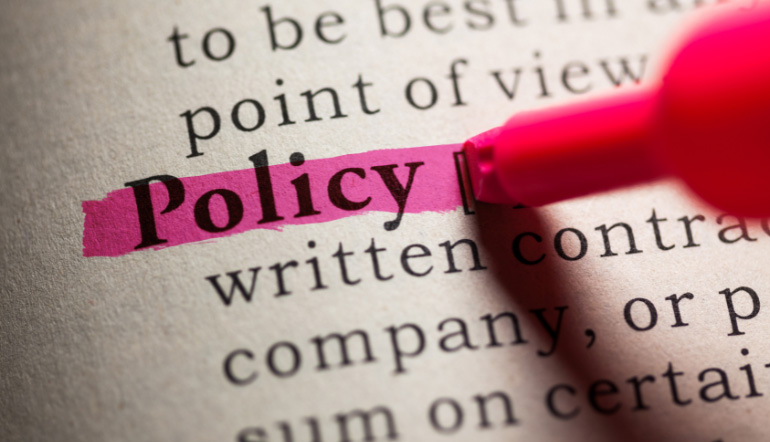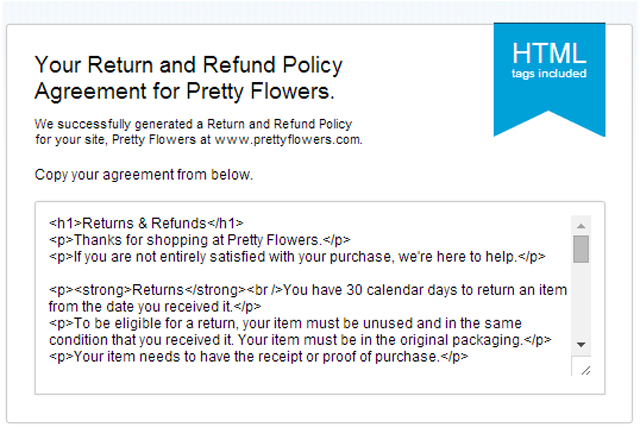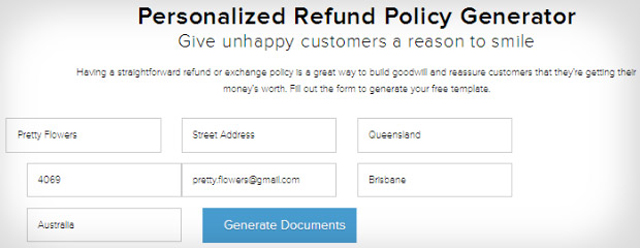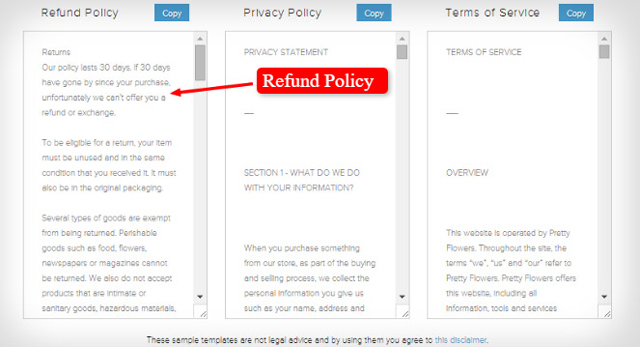
The aim of this lesson is to help you as a future eCommerce copywriter write a refund policy for an online store by understanding the elements you can include and by using refund policy generators.
Customizing refund policy to fit the nature of every online store is highly advisable.
Wondering why an online store would need such a page?
Here’s why…
Sometimes when customers are NOT satisfied with the product or service they received – either because of low quality or the product failed to work as expected – they return them and ask for a refund.
Returns may either be converted to refund or exchange.
This may not be a good thing for store owners and business in general, but do take note that it’s best to deal with refunds positively. It can affect your relationship with your customers, and it has the potential to make or break your store’s success.
In dealing with refunds, you need to create a policy that the whole team can follow in order to properly accommodate customers’ refund concerns.
A refund policy is synonymous with return policy, and it is a set of guidelines that you can follow when dealing with returns and refunds for returned products. This includes how and when a customer can claim a refund within a specific time frame.
Most customers are interested in a store’s return policy because they want to be assured that in case the products they purchase fail them, returning them will NOT be a hassle. This greatly affects their purchasing decisions as well.
So, let’s take a closer look at how you as a copywriter can create this page to help all your customers’ product purchase and possible return hassle-free.
First, we’re going to point out why it’s so significant and how it can affect an online store.
The Effects of a Well-Crafted Refund Policy
You’ve realized that it is important to create a clear, concise, fair, and appealing refund policy, right? Sure.
But you still wonder why exactly it matters? Because it can do the following…
- Improve customer service and experience
When an unsatisfied customer comes back to return what he purchased and asks for a refund, this gives him a negative view of the store. You can win customers back by providing a fair and friendly refund or exchange. Note that they’ll be able to value your effort in going that extra mile on customer service. - Attract and keep customers
A well-written and fair refund policy can be used as a marketing strategy to give customers a sense of security and that the products are of high quality and will work as expected.
A good example could be including a “Money-Back Guarantee” within the refund policy. - Set customers’ expectations
A clear refund policy can set customers’ expectations on certain circumstances such as when and how they can claim a refund.
For instance, specifically state the number of days for the money-back guarantee such as “30-Day Money-Back Guarantee”.
What if, unfortunately, the product they had purchased failed after the 30-day period?
As sad as it is, most customers would be able to understand that they can NO longer claim refunds as it is clearly stated on the Refund Policy that Money-Back Guarantee is only good for 30 days.
Pretty simple and straightforward, right? - Win customers’ trust
A refund policy also provides assurance that the products they’ll get from you are in good condition, and it will give them the idea that it’s safe to return the product in case they’re not satisfied with it or if it’s damaged.
In making your own refund policy, it is essential to state what your customers might want to know beforehand to assure them that they are buying from a secure and credible e-store.
This will also help reduce the time you’ll spend on refunds, address customer issues/concerns, and improve sales.
Once you’ve created a refund policy for an online store, it is best for its owner to have it checked by an attorney in order to ensure that it adheres to local and/or federal laws.
OK. Now you’ve seen how important this page is for every eCommerce business, you’re going to find out how to create it.
Ready? Let’s move on.
The following are essential elements you can include in an e-store’s refund policy.
1: State What Your Customers Can Return
Depending on the location of an online store’s headquarters and what the law states, you need to know the product types or categories that are not accepted for returns. You can acquire a list of such products from the local government prior to creating a refund policy for an e-store.
Stores selling perishable goods, customized products, non-resalable goods due to poor handling/conditions or for health considerations, and goods without tags/receipts/invoices/packaging may not be able to include these products in their refund policy.
So, do your research before writing this page.
Check with the local government regarding the legal documents governing returns and refunds in order to accurately state what your customers CAN and CANNOT return.
2: List the Expected Refund Amount
Ensure to list down the expected refund amount of the product to be returned.
Taxes can be refunded, but shipping fees are usually NOT included in the refund. Stocking fees, if charged to the customer, should be included in the policy.
Provide the customers with the calculation you use, so that they can calculate the exact amount they’ll receive.
3: Specify the Return Period
Consider the following key factors to help you define a specific return period:
- The limited number of days that your payment processor/s store credit card information – if you don’t know about this, you won’t be able to refund customers
- Order delivery time
- Shipping time
Indicate the start of the return period:
- Is it the day the customer purchased the product?
- Is it the day the product is shipped?
- Is it the day the customer received the product?
Include the required activity that must be completed before the return period ends:
- Should customers just ship the return?
- Should you receive the physical product first?
Specify the number of days it will take for you to process the refund and ensure customers are regularly updated with their return status.
4: List the Address for Returns
List the complete address for product returns and make sure to include the department.
To be sure that customers ship the returns to the right location, include a return slip which customers can tape on the product’s packaging.
Make sure to specify who shoulders the postage fee. If customers are to pay for postage, it’s possible they’ll choose a cheaper shipping service which is often unreliable.
What you can do is insure products with tracking services, regardless of who’s paying the postage fee.
5: Clearly State Whether You Accept Exchanges or Not
If you accept exchanges, specify if the product(s) can be exchanged with other items or store credit. Specify the process, how long it takes, and what fees/charges are included.
If you do NOT accept exchanges, make sure it is stated clearly on the refund policy.
6: State Special Circumstances
If you run sales, it is often assumed that products cannot be returned. But this truly depends on the store, so it’s best to explicitly state if there’s an applicable return/refund policy for sales.
Whether you mention the products on sale are “as is”, “buy one get one”, “all sales are final”, and others, clearly state that these products will NOT be accepted back for refunds.
To protect an eCommerce business against losses due to “past dues“, it’s best to enforce a strict refund policy.
However, if you don’t want to dissuade customers from buying, make sure to let them know what will happen exactly if products are returned past the return period (e.g. offer discounted refund or store credit, and so on).
7: Include a Clause for Discretionary Updates/Changes to the Policy
This clause allows you to make reasonable updates to your store’s refund policy at your discretion based on your customers’ shopping routines.
Helpful Refund Policy Generators
You can choose among the following free refund policy generators to help you get started.
But, make sure to personalize your refund policy to suit the nature of a specific store and to include important contents mentioned above.
1: TermsFeed

TermsFeed lets you create a refund policy in just five simple steps by providing the store’s information, as well as other details that you want to include in the policy.
It can also display a generated refund policy with HTML tabs, so you can easily transfer it to WordPress or other platforms.
Here’s a quick video guide on how to use this tool:
So, these are the basic steps to take:
- On the site, click on the Generate Your Return and Refund Policy button
- Enter the site information
- Enter the company location
- Provide Return details depending on the nature of the store
- Enter the email address to where the Refund Policy will be sent
- You’ll now have a generic Returns Policy available for your store, with HTML tags for easier transfer

In case you need it, you can get this free Generic Return and Refund Policy Template from this valuable tool. Isn’t it super helpful?
For PDF or DOCX file versions of the same template, many other details and plenty of great examples, you may refer to their Sample Return Policy for eCommerce Stores.
It’s always best to learn from appropriate examples, isn’t it?
2: Shopify free Refund Policy generator

With just one step, you can create your very own refund policy, terms of service and privacy policy at the same time through this Shopify Refund Policy Generator.
However, these are generic policies and are subject to revision and updates. You can use and edit them to suit any particular online store’s needs.


Learn From Others
As we’ve said, it’s best to learn from either outstanding or poor examples. Don’t you agree?
Thus, here are a few refund policy samples from very good eCommerce stores for you to learn from. Check them out and see which part(s) of their refund policies is/are applicable to the store you’re writing for.
Example 1: Zappos Shipping and Refund Policy

Zappos provide a very generous refund policy to customers as they allow 365-day limit to return or exchange the products bought from them, provided that the item is in good condition and in the original box/packaging.
One notable thing is that the shipping is free for both orders and returns. It is so appealing to customers because they can order several items and send them all back if nothing suits them.
Customers can also process a Self Service Return for a full refund according to their step-by-step Self Service Return Instructions.
Example 2: Macy’s Return Policy

Macy’s has one of the most loved return policies that allow customers to return an item and get a refund within a 180-day period. However, shipping for online purchases is not refundable, but they allow items to be returned to the store without any cost.
Processing refunds and returns can also be made directly online by following their easy return instructions.
Also, you can take a peek at some more details about their Returns & Exchanges if you follow all the links provided. Learn and have fun!
Example 3: Amazon’s Returns and Refunds

Amazon may NOT have the best refund policy that customers love, but it provides a very detailed and comprehensive refund policy. They also provide different conditions as to how customers can process and claim refunds depending on the payment method they used.
You can also follow this link to check out their detailed refund information.
Besides these, check out 16 more fantastic examples you can find in a Bigcommerce article Ecommerce Return Policy Template: How to Write a Returns and Refunds Policy to 3X Sales [Examples Included].
Make sure you thoroughly read this blog post because you can learn a lot from it. Do NOT hesitate to refer to their professional tips and guidelines when creating a Refund Policy for an online store.
The same goes for their another equally useful blog article Ecommerce Return Policy: How to Write a Returns and Refunds Policy. Isn’t it helpful and full of examples?
Another useful source, Return & Refund Policy Templates, shows the current 2018 best practices that you need to know when it comes to these kind of policies for ecommerce stores. This makes it worth checking!
In addition, here are a few more good articles that deserve your full attention:
- 9 Tips on Creating an eCommerce Return Policy
- 5 Ways To Create An eCommerce Return Policy That Drives New Sales
- Why Your eCommerce Return Policy is More Important than Ever
- 4 Tips for Better eCommerce Returns and Exchanges
When done exploring all these wonderful expert sources, we can wrap up this lesson.
In Summary
In this lesson, you’ve learnt about what exactly a Return and Refund Policy is and how it can affect an eCommerce business.
Also, you now know what key elements to include in such a page and which free tools you can use to help you come up with a perfectly customized Refund and/or Return Policy for any online store.
Here are some good slides which summarize the main learnings from this lesson and provide some examples:
Congratulations! So far you have:
- Understood what a refund policy is
- Learnt the elements that make an effective and customer-friendly refund policy
- Learnt how to create a refund policy using refund policy generators
- Learnt how to customize your generic refund policy to suit a specific online store
- Learnt more from well-known eCommerce stores’ refund policy examples
- Seen what part(s) of their refund policies is/are applicable to any other online store you are or will be writing for
Frequently Asked Questions
1. Why does an online store need a Refund or Return Policy?
a. Because sometimes when customers are dissatisfied with the product or service they received, they return them and ask for a refund or exchange. Then, the whole store team needs to follow the same procedure in order to properly accommodate the customers’ refund concerns
b. Because such a policy assures the customers that in case the products they purchase fail them, returning them will be hassle-free, which then greatly affects their purchasing decisions and instills trust
c. Because a clear Refund Policy can set customers’ expectations on certain circumstances such as when and how they can claim a refund
d. All of the above
2. What are the essential elements of a Refund Policy?
a. Stating what customers can return, whether or not a store accepts exchanges, as well as stating any other special circumstances
b. Listing the expected refund amount, the address for returns,and specifying the return period
c. Including a clause for discretionary updates based on the customer’s shopping routines
d. All of the above
3. eCommerce copywriters can create a Refund or Return Policy for online stores using one of the free generators.
a. Yes! It’s enough just to type in a few details and generate a perfect version of this policy for any online store. They’re basically all the same so it’s a real no-brainier. Yes! It’s enough just to type in a few details and generate a perfect version of this policy for any online store. They’re basically all the same so it’s a real no-brainier
b. Yes, but it’s necessary that the Refund Policy is customized and personalized for every online store
c. No. there aren’t any tools to help copywriters generate e Refund Policy for an online store
